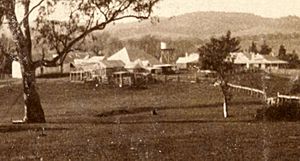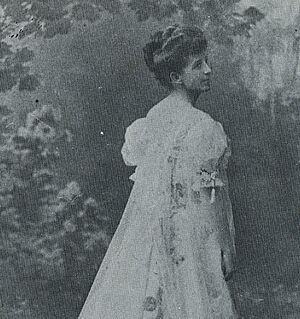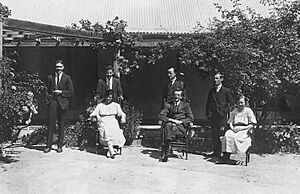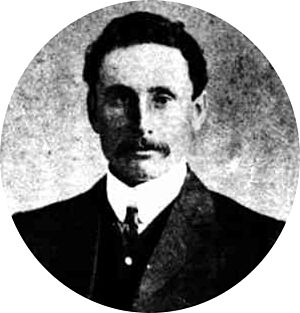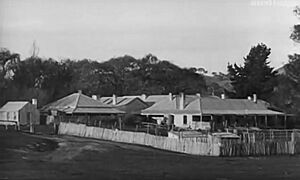Tuggeranong Homestead facts for kids
Tuggeranong Homestead is a very old and important property in the Australian Capital Territory. It is located in the area now called Richardson. This homestead is special because of its long history. It is even listed on the ACT Heritage Register, which means it's protected.
Many important farmers and landowners owned the homestead over the years. Eventually, the government took ownership of it. Today, Tuggeranong Homestead is a popular place for events. People use it for conferences, special gatherings, and even weddings.
Contents
Who Owned Tuggeranong Homestead First?
The first person to officially own land in the Tuggeranong area was Peter Murdoch. He was an assistant to Governor Thomas Brisbane. In 1827, Murdoch was given a large piece of land. It was about 2,000 acres (8 square kilometers).
In 1829, Murdoch moved to Tasmania. The land then became part of a grant to John McLaren. McLaren came from Glasgow in 1828. His property was called Janevale. McLaren's partner, William Wright, managed it as a cattle farm. The name "Tuggeranong" originally referred to the whole area. This included places like Wanniassa and Lanyon. In 1835, McLaren sold the property to Thomas Macquoid.
The Macquoid Family's Time
Thomas Macquoid bought the property in 1835. He was the Sheriff of the Supreme Court of NSW. He renamed the property "Waniassa." This name came from an estate in Java where he had grown coffee.
Macquoid built a stone cottage and a barn. He used workers who were convicts to help him. The barn is still there today, though it's used differently now. Part of Macquoid's original cottage was later added to the homestead's main living room in 1908.
In 1841, Macquoid faced very hard times and passed away. His son, Hya Macquoid, took over the property. He worked hard to pay off his father's debts. Sadly, Hya Macquoid was lost at sea in 1857. This happened when the ship Dunbar sank near Sydney. His body was never found.
The Cunningham Family and Sheep Farming
The land was put up for sale in 1858. Andrew Cunningham, who owned Lanyon, bought it. In 1874, Andrew's youngest son, James (Jim) Cunningham, moved to the property. He called it "Tuggranong." Jim lived in a small stone cottage there.
In 1889, Jim was 39 years old. He married 19-year-old Mary Twynam. Mary's father was Edward Twynam, a very important surveyor in NSW. You can see a photo of Mary from around that time. Jim and Mary had eight children over the next twelve years.
Mary was a great farmer's wife. She went to fancy balls and helped raise money. She supported the local church and hospital. The homestead became a lively place for social events. Mary and Jim often hosted many gatherings there.
Tuggeranong became a very successful sheep farm. They would shear up to 50,000 sheep each year. The shearing season usually began in early November. About twenty-five men were hired for this job. Some were local, but many came from places like Tumut or Gundagai. They were often small farmers earning extra money.
After shearing finished, usually in early December, there was a big party. It was called the Shearers Ball. It was held in the woolshed, and everyone in the community was invited. A newspaper in 1898 described it as a "great success." Visitors came from nearby towns like Queanbeyan and Tharwa. The woolshed was beautifully decorated, and there was plenty of food in another building.
The Cunningham family left Tuggeranong Homestead in 1914. Jim had bought Lanyon after his brother passed away. The government then took over the land. It became part of the Federal Capital Territory. In 1919, Charles Bean was allowed to use the Homestead. He needed a quiet place to write Australia's history of World War 1.
Charles Bean and His Team of Historians
Charles Edwin Woodrow Bean was asked by the government to write a huge history book. It was about Australia's part in World War 1. He and his team started this project in Melbourne in 1919. But too many soldiers returning from the war kept interrupting them. So, they decided to move to a peaceful place. Tuggeranong Homestead, now owned by the government, was perfect.
The team moved there in October 1919. They stayed until April 1925. The Homestead had living spaces and offices for most of the staff. Two married men lived with their families in small cottages nearby. Behind the house was a large field. Here, the team kept their horses, a few sheep, and a cow for milk. Water was pumped from Tuggeranong Creek.
Years later, Charles remembered how peaceful the property was. He said, "In the country air our nerves were easily refreshed by an hours ride. The garden of Tuggeranong under its beautiful trees became one of the sights of the Capital. In summer we arranged our own daylight saving and had tennis every evening."
In 1920, Charles met Ethel Young. She was a nurse at Queanbeyan Hospital. She came to one of their tennis matches. He married her the next year, and she also lived at the Homestead.
Besides tennis, the team loved cricket. They built a strong cricket pitch, which is still there today.
After they left in 1925, the Homestead was empty for two years. Then, in 1927, Timothy McCormack leased the property.
The McCormack Family's Legacy
Timothy Joseph McCormack managed Tuggeranong Homestead from 1927 until he passed away in 1938. He also had other properties in Crookwell and at Royalla. Timothy was born in 1873 near Crookwell. His father, also named Timothy, worked on a farm.
In 1899, Timothy married Mary Kennedy in Crookwell. Mary's father was William Kennedy, a local councilor. Timothy and Mary had five children: three sons and two daughters.
Timothy leased Tuggeranong in 1927. He turned it into an excellent grazing property. It produced very high-quality merino wool. He also grew grain crops and improved the pastures. The Homestead became a hub for sports and social events. He even built a racetrack on the property. Timothy owned several champion racehorses.
Timothy passed away in 1938. The McCormack family continued to operate Tuggeranong until 1974. At that time, the government took the land for new suburbs.
Today, many Canberra suburbs are built on the original property. But the homestead itself has been saved. It sits on 65 acres (about 263,000 square meters) of land. The historic property now hosts the Tuggeranong Homestead markets. These happen on the first Sunday of every month. It is also home to the Calwell Scout Group.
Images for kids
- Barrow, G (1998). Canberra's Historic Houses. Dagraja Press, ACT. ISBN: 0-9587552-2-1.
- Gillespie, L (1991). Canberra 1820 - 1913. AGPS, ACT. ISBN: 0-644-08060-4.
- Moore, B (1982). The Lanyon Saga. Moore, ACT. ISBN: 0-9594649-2-1.
- Lamb, R. (2006). Macquoid of Waniassa: Portrait of a Colonial Sheriff, Waniassa Publications, ACT, ISBN: 0-9775237-0-5.


